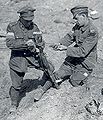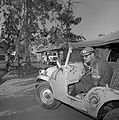Armlets
|
(Description in progress)
[...]
In 1922, pending a further decision with regard to the post-war dress of the Canadian Militia, orders were issued[1] which included the wearing of armlets.[2] Blue and white armlets 3 1/2 inches wide were authorized to be worn on the left arm above the elbow by Officers engaged on special duties with the Signal Service as well as warrant officers, non-commissioned officers and men of the Signal Services when actually on duty.
In 1927 Regulations for the Clothing of the Permanent and Non-Permanent Active Militia were amended to add further instructions for the wearing and provision of the armlets.[3] They were to be worn by personnel of all branches actually performing signal duties:
- (a) On active service.
- (b) When performing Signal duties with other troops at training or manoeuvers, &c.
- (c) When specifically ordered.
The armlets were to be worn on the right arm above the elbow. In the Permanent Active Militia they were provided on a scale of two per Signal Warrant Officer, N.C.O. and man and, in other units, two per signaller on the establishment. In the non-permanent militia, the scale was half that of the permanent force.
Changes were recommended in 1933 when it was noted that the armlets were being worn by so many people that they had lost their significance and had become a decoration peculiar to signal personnel.[4] In 1935 changes were promulgated for both the Permanent and Non-Permanent Active Militia[5] stating that the blue and white signal armlets would only be worn on active service, during training or manoeuvers:
- (i) Royal Canadian Corps of Signals / Canadian Corps of Signals officers, regimental signal officers and N.C.O.'s in charge of battery signallers.
- (ii) Despatch riders, and signallers of all arms while employed as motor cyclist orderlies.
- (iii) N.C.O.'s of all arms in charge of, or employed in, signal offices.
- (iv) Royal Canadian Corps of Signals / Canadian Corps of Signals personnel engaged in construction or maintenance of lines.
Canadian Active Service Force Routine Order (CASF RO) 1228 (10 Nov 1941) directed that signal armlets were to be worn on both arms.
CASF RO 4553 dated 3 May 1944 outlined restrictions on the use of the signal armlet similar to the 1935 amendments. It was noted the purpose of the blue and white armlet was to denote persons on urgent inter-communication duties to ensure they were immediately recognized and not unduly delayed or hindered. The order also directed that the armlet not be worn where there was a danger of its attracting enemy fire to its wearer.
After the Second World War, Canadian Army Routine Order 6635 and Canadian Army Overseas Routine Order 6642[6] restricted the wear of the blue and white armlets to despatch riders.
Provisional Orders and Instructions for Dress of The Canadian Army published in 1953 restricted the wearing of the blue and white armlet, now termed a brassard, to RC Sigs lineman and despatch riders.[7]
[...]
Standard Style
Other Styles
Photos
References
- ↑ General Order 148 of 1922
- ↑ In some cases this was in lieu of gorget patches (introduced in G.O. 107/1918) which were restricted to General Officers and substantive Colonels.
- ↑ Appendix to MO 388 and 389 of 1927. 29 Jun 1927.
- ↑ Library and Archives Canada. RG 24 Vol 5930. H.Q. 96-11-159. 10 July 1933.
- ↑ General Orders 36 and 37 of 1935
- ↑ Canadian Army Overseas Routine Order 6642, 8 Aug 1946.
- ↑ Provisional Orders and Instructions for Dress of The Canadian Army, 15 October 1953. Article 201.05.








